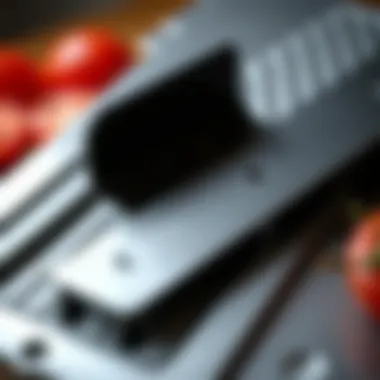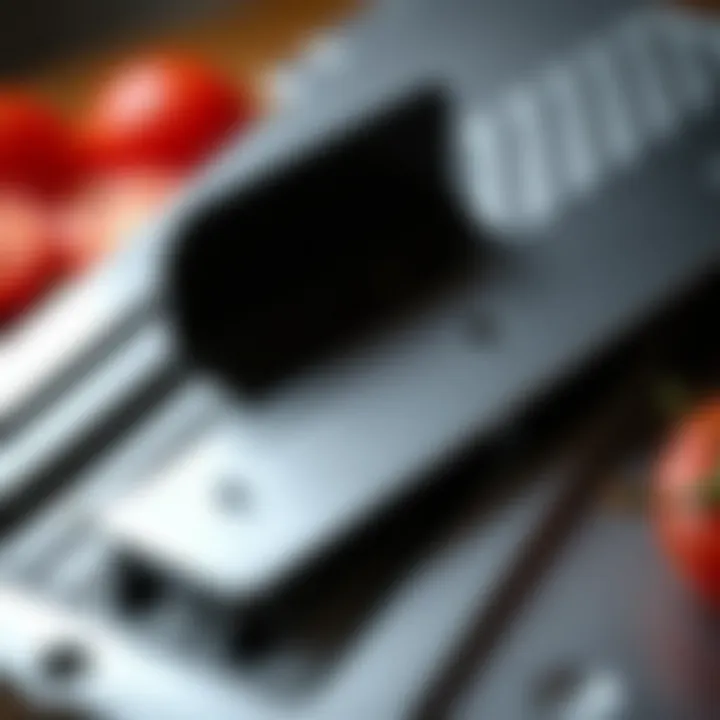The Best Mandoline: A Comprehensive Exploration


Intro
In the bustling world of culinary arts, a mandoline slicer stands out as a staple tool, offering precision and efficiency that can elevate even the simplest of dishes. For those who are keen to wield a blade that can produce uniform slices, julienne cuts, or paper-thin vegetables, knowing what to look for can save time and frustration. With an ever-expanding variety of styles and features on the market, navigating the options may seem daunting. This guide aims to clarify the function, benefits, and range of mandolines, ensuring both novice and seasoned cooks can make informed decisions.
Ingredients Breakdown
Primary Ingredients
While using a mandoline, the focus often lies on fresh produce, which serves as the primary ingredient. Key vegetables include:
- Potatoes – Perfect for creating crispy chips or casseroles.
- Carrots – Ideal for salads, stir-fries, or as garnishes.
- Onions – Handy for even slices in sautés or soups.
- Zucchini – Excellent for garden-fresh salads or ratatoule.
Each of these ingredients can be transformed with a little precision, showcasing not only the utility of a mandoline but also enhancing dish presentation.
Optional Ingredients
A few additional options can certainly broaden the playing field, especially for those adventurous in the kitchen:
- Radishes – Add a peppery kick to salads.
- Beets – Brighten any plate with color and sweetness.
- Apples – Offer crisp, thin slices for salads or tarts.
These optional ingredients not only add variety but also allow for creativity in meals.
Essential Kitchen Tools
Accompanying a mandoline, a few kitchen tools are essential for optimal usage:
- Cut-resistant gloves – Safety first; hands should remain protected during slicing.
- Non-slip cutting board – Ensures stability throughout the slicing process.
- Quality knife – For any necessary prep work that requires the finer edge.
Using these tools alongside the mandoline can make for a safer and more productive cooking session.
Step-by-Step Preparation
Prepping the Ingredients
The success of any cutting technique with a mandoline relies on how well the ingredients are prepared. Begin by washing all produce thoroughly to remove dirt. Trim them into manageable sizes – for instance, cut potatoes into halves or quarters, helping them fit safely through the slicer.
Cooking Techniques and Methods
While a mandoline specializes in slicing, understanding the technique is vital. Move the ingredient across the blade in a consistent manner, using firm pressure without forcing the item. This will yield better results, be it with vegetables for a fresh salad or for layering in gratins.
Assembly and Presentation Tips
Finally, think about how you can elevate your dish through presentation. Arrange slices artfully on the plate, color contrasting vegetables together to create a visual feast. For example, alternating thin slices of zucchini and beet can create a stunning tart or salad.
Dietary Considerations
Gluten-Free Options
Cooking with mandolines naturally lends itself to gluten-free dishes. Fresh vegetables can shine as the main feature in gluten-free salads or veggie platters, making it easy to provide flavorful options.
Vegetarian and Vegan Substitutes
For those focusing on plant-based diets, mandolines are a boon. They can slice tofu, produce thin strips of eggplant, or even create vegetable noodles that easily take the place of traditional pasta.
Nutrition Facts & Nutritional Considerations
Incorporating a variety of sliced vegetables can enrich meals with nutrients. Gradually integrating different produce like beets and chard can ensure a wide spectrum of vitamins and minerals are included.
Variations and Customizations
Flavor Enhancements
Add zest to your mandoline creations by utilizing herbs and spices. Tossing freshly sliced veggies with olive oil and sea salt, paired with fresh garlic or herbs, can enhance the flavors tremendously.
Alternative Cooking Methods
Not only are mandolines suitable for raw preparations, but creativity extends into the oven. Thinly sliced potatoes make for delightful au gratin, while other vegetables can be used in oven-baked dishes for a different texture.
Pairing Suggestions (Sides, Drinks, etc.)
To complement dishes made with a mandoline, consider serving with rice or quinoa. A light vinaigrette drizzled over the arrangement can awaken the flavors. When it comes to beverages, pairing fresh vegetable dishes with white wine or homemade lemonade can enhance the dining experience.
Common Questions and Answerss and Troubleshooting
Frequently Asked Questions
- What is a mandoline? A mandoline is a slicing device that can create uniform cuts of vegetables and fruits.
- Are mandolines safe? When used correctly and with proper safety tools like gloves, they are quite safe; however, caution is always recommended.
Common Mistakes to Avoid
- Not securing the mandoline properly or failing to utilize safety gloves can lead to accidents.
- Pressing too hard can result in uneven slices, so allow the weight of the ingredient and the tool to do the work.
Solutions to Potential Problems
If slices come out uneven or break, adjust the speed and pressure applied. Sometimes, a quick reset of the position of the blade may be necessary too.
"A mandoline enriches not only the food prepared but also enhances the skills of those who dare to master it."
In the end, a thorough understanding of mandolines can significantly improve your culinary endeavors. Pinpointing the right tool, ingredients, and techniques can be the difference between ordinary and extraordinary dishes.
Understanding the Mandoline
In the bustling realm of culinary arts, the mandoline occupies a unique and significant place. This tool is not merely an accessory; it embodies convenience and precision in food preparation. Understanding the mandoline's purpose and its key features is essential for anyone looking to enhance their culinary skills.
The ability to achieve uniform cuts consistently can transform how a dish is presented, impacting not just aesthetics but also cooking times. This makes the mandoline invaluable in both professional kitchens and home settings. Whether you’re slicing vegetables for a stir-fry or creating thin potato chips for a snack, a mandoline can save time and elevate the quality of your food.


Furthermore, the insights into adjustable slicing thickness, material and durability, and ease of storage will shed light on what sets apart a good mandoline from a great one. As we journey through this exploration, you'll find that understanding these elements will aid in selecting the right mandoline to suit your culinary needs.
The Purpose of a Mandoline
A mandoline serves several purposes, chief among them being efficiency and precision. This versatile kitchen tool allows cooks to slice, julienne, and sometimes even dice, fruits and vegetables with ease. The design of a mandoline facilitates consistent cuts, ensuring that ingredients cook evenly—a crucial factor in achieving culinary success. For the home cook, it simplifies meal prep, providing a way to prepare larger quantities of food without the weariness that comes from repetitive manual slicing.
In professional kitchens, time is often of the essence. Chefs rely on mandolines to expedite service while maintaining quality. Similarly, the mandoline fosters creativity in the kitchen, allowing for intricate presentations that impress diners and friends alike.
Key Features to Consider
When choosing a mandoline, several features warrant consideration, as they can significantly influence your food preparation experience.
Adjustable slicing thickness
The adjustable slicing thickness feature is fundamental to a mandoline's versatility. This allows users to customize the thickness of their cuts, which can range from a delicate paper-thin slice to a robust thicker cut, depending on the dish being prepared. A key consideration is how easily this adjustment can be made, as cumbersome mechanisms can detract from the tool's effectiveness.
A unique quality of adjustable slicing thickness is the ability to create uniform pieces, crucial for even cooking. This contributes to not only aesthetic appeal in presentations but also ensures that all ingredients heat through at the same rate.
Material and durability
The material and durability of a mandoline play a vital role in its longevity and overall performance. Common materials include stainless steel for blades and high-quality plastic for the body. Stainless steel is known for its longevity and ability to stay sharp, enabling you to work efficiently without frequent replacements.
However, lighter materials may offer easier handling, especially if you plan to store your mandoline away after use. It’s essential to find a balance that aligns with your cooking style, since investing in a more durable mandoline can save you from frequent replacements while ensuring safe and effective usage.
Ease of storage and handling
In terms of ease of storage and handling, the design of the mandoline itself can be a game changer. Some models fold up, allowing for compact storage, while others come with built-in handles for transportation and a lighter feel in everyday use.
A compact model may be ideal for small kitchens, as it doesn’t take up much space, yet retains the functionality needed for various tasks. However, it is also important to consider whether the design enables safe handling during use. Features such as handguards and stability grips can contribute significantly to safety, proving essential for novice users.
Understanding these key features can help demystify the world of mandolines. By recognizing what to look for in adjustable slicing thickness, material and durability, and ease of storage and handling, one can make an informed decision that enhances their cooking experience.
Types of Mandolines
When it comes to enhancing your culinary skills, understanding the different types of mandolines available is crucial. Each type comes with its unique features, functionalities, and specific uses, catering to a broad spectrum of cooking needs. These kitchen tools vary not just in design but also in their capabilities, making it essential to choose a mandoline that aligns with one’s cooking style and frequency of use. Here’s a closer look at the four main types of mandolines available today.
Standard Mandoline
A standard mandoline often features a simple design that’s both user-friendly and effective. Typically made from stainless steel or high-quality plastic, these models allow the user to adjust slicing thickness manually, offering quite a lot of versatility for various preparation tasks. The blades are usually fixed, which may require more manual effort than other types, but many cooks appreciate the tactile feedback that comes from using these devices.
The benefits of a standard mandoline include:
- Affordability: Generally, these can be quite budget-friendly, making them appealing for home cooks.
- Portability: Due to their lightweight nature, they are easy to store and transport when needed.
- Control: Many users feel they have more control over the slicing process when using a manual model, which can be crucial for achieving the desired thickness.
Electric Mandoline
In a world where convenience often trumps effort, the electric mandoline stands out. Designed for those who want to save time in the kitchen, these devices slice, julienne, and even shred food with the press of a button. While they can be pricier than their manual counterparts, the efficiency they provide is hard to argue against.
Here are some notable points about electric mandolines:
- Speed: They can rapidly slice large quantities of vegetables, making them ideal for big meals or batch prepping.
- Variety of Cuts: Most models come with interchangeable blades, allowing for various cuts and even the ability to make different shapes, from thin chips to thicker slices.
- Less Physical Effort: For those with wrist issues or who dread repetitive tasks, an electric model might be a lifesaver.
Japanese Mandoline
The Japanese mandoline, often referred to as a kabu, embodies elegance and precision typical of Japanese craftsmanship. Renowned for their sharpness and the quality of the cuts they produce, these mandolines are favored by chefs and home cooks alike who prioritize aesthetics in their food presentation.
Some characteristics of a Japanese mandoline include:
- Precision Cuts: The blades of these mandolines are often designed to achieve ultra-thin results, perfect for delicate garnishes or sushi prep.
- Compact Design: Many models are trendy to be somewhat compact, making them perfect for kitchens where space is at a premium.
- Traditional Craftsmanship: Often handmade, they embody a craftsmanship that is deeply respected in Japanese culture, not just as a tool but as a piece of art.
Multi-Purpose Mandoline
For the versatile cook, a multi-purpose mandoline is a worthy addition to the kitchen arsenal. These tools are designed to provide several functionalities, combining the benefits of different types of mandolines into one package. They may have interchangeable blades and various attachments that allow the user to adapt the tool to their needs seamlessly.
Benefits of a multi-purpose mandoline include:
- Adaptability: A single device can do many jobs, from slicing to grating, which can minimize the need for multiple tools.
- Storage Efficiency: They can often replace several standalone devices, saving valuable kitchen space.
- Cost-Effective: While the initial cost may be higher, in the long run, these versatile tools may save money on purchasing multiple kitchen appliances.
All in all, selecting the right mandoline type hinges on understanding personal cooking needs and habits. Whether you lean towards manual control, require speed or precision, or seek versatility, there is a perfect mandoline waiting to help you elevate your culinary adventures.
Selecting the Best Mandoline for Your Needs
When it comes to choosing a mandoline, understanding your unique needs is crucial. The right selection can streamline your food prep, add flair to your plates, and even make healthy eating a bit easier. Everyone's kitchen has its quirks, and your choice of a mandoline should reflect that. Let's break down the major factors to keep in mind when making this decision.
Assessing Your Cooking Habits
Frequency of use
Your cooking routine significantly influences the type of mandoline that's ideal for you. If you're whipping up gourmet meals every day, you’ll benefit from a durable and versatile mandoline that can handle a range of tasks. Conversely, if you only plan to slice vegetables occasionally, a basic model might do the trick.
Higher frequency users often prefer models with adjustable blades, as they can save time on prep work. This characteristic makes it easier to switch between different cuts, from paper-thin slices for salads to thicker cuts for stir-frying. However, a more advanced mandoline comes with its advantages and disadvantages. On the one hand, advanced features can improve your cooking experience; on the other, they can lead to overcomplication. You should weigh how often you'll use it against how much effort you're willing to put into learning its features.
Types of food preparation
The specific methods you employ in the kitchen also play a role in selecting your mandoline. If you’re mainly preparing salads or garnishes, a blade that excels in thin, even slices is essential. Alternatively, bulk prepping for cooking techniques that require julienne strips, like stir-fries, would necessitate different functionalities.
Understanding your food preparation methods helps to identify what features matter most to you. Mandolines designed for versatility may also offer various blade options allowing multiple cuts on a single tool. This can mean you get a versatile experience from a single device. Yet, a model focusing heavily on a specific function might not have the adaptability you need for various tasks. It’s important to consider your cooking style and how a mandoline can complement it.
Budget Considerations
A key factor in selecting a mandoline is finding a balance betwen cost and quality. While it’s tempting to go for cheaper options, this might lead to disappointment.
Cost vs. quality
The correlation between price and functionality often stands out. Higher-quality mandolines may carry a larger price tag but are usually made from better materials that withstand regular use. They often feature improved safety mechanisms and ease of use, making cooking more enjoyable in the long run.


On the flip side, budget-friendly models can be a suitable choice for occasional users or those just starting in their culinary journey. They can still provide satisfactory results, but they might not last for years or withstand rigorous daily demands. It’s important to evaluate how much you’re willing to spend and your commitment to cooking before making a choice.
Long-term investment
Looking at a mandoline as a long-term investment can shift your mindset when shopping. Initially, the cost of a high-quality mandoline may feel daunting. However, consider the potential savings in time and the enhanced culinary experience it can provide over months or even years.
A model built to last not only saves you money over time but also fosters a positive kitchen environment. The experience of using a tool that works reliably encourages more frequent cooking and experimentation. Nevertheless, a long-term investment requires initial trust; if you're not ready to make this leap, it may be wiser to consider what models suit short-term needs before deciding to invest heavily.
"Choosing the right mandoline is not just about slicing vegetables; it's about enhancing your entire cooking adventure and making life a bit easier in the kitchen."
In summary, selecting the best mandoline requires a clear understanding of your cooking habits along with budget considerations. Are you the daily chef or do you find yourself in the kitchen only a few times a month? Think about the types of food you prepare and how often you plan to use the mandoline. With these factors in mind, you can find a model that meets your needs efficiently and effectively.
Safety Considerations in Mandoline Use
Using a mandoline can be a boon for any kitchen enthusiast, elevating your food preparation to a new level of efficiency and precision. However, with the sheer sharpness of the blades involved, it’s crucial to recognize the importance of safety considerations when using this tool. Safety precautions not only protect you from injuries but also extend the life of your equipment. When you're working with a device that can slice through vegetables like a hot knife through butter, being mindful of how to handle it is paramount.
Using Protective Equipment
In the kitchen, there’s often a saying: "An ounce of prevention is worth a pound of cure." This especially holds true when it comes to mandoline usage. Protective equipment is not just a luxury; it’s a saviour for your fingertips.
Cut-resistant gloves
Cut-resistant gloves are essentials when working with a mandoline. These gloves are usually made from high-performance materials that do not compromise on comfort or dexterity. One of their biggest strengths is their ability to provide protection without hindering your movement. While slicing vegetables, these gloves can mean the difference between a minor cut and a trip to the hospital.
A critical characteristic of cut-resistant gloves is their level of protection, often rated using the EN 388 standard. This rating indicates how well the glove can withstand cuts, tears, and abrasions. For most culinary tasks involving a mandoline, gloves with a cut level of 3 or higher are typically recommended. Their popularity stems from this reliable defense, giving users peace of mind while they create culinary masterpieces.
However, they do come with a caveat; while many boast high protection levels, they can sometimes make the hands feel overly hot during extended use.
Hand guards
Hand guards serve as a safeguard for those clumsy moments we all have in the kitchen. These implements act as a physical barrier between your fingers and the sharp blades of a mandoline. A unique feature about hand guards is that they are designed to hold onto what you’re slicing while offering substantial protection. They often come equipped with prongs or grips that secure fruits or vegetables firmly.
Their main selling point lies in their simplicity; they are easy to use and remove, allowing for efficient food prep without the constant worry of injury. However, some users find them cumbersome at times, as they might obstruct views during slicing, leading to minor frustration when attempting to monitor the thickness of your cut.
Proper Technique
While protective equipment plays a significant role in ensuring safety, mastering proper technique is fundamental. Knowing how to position your hands and apply the right pressure improves both safety and cutting proficiency when you’re using the mandoline.
Correct positioning
"Position makes perfect," as the saying goes. Correct positioning of your hands is crucial when utilizing a mandoline. This fundamentally ensures that you’re not only safe but also achieving consistent results. Keeping your non-dominant hand atop the ingredient, while pushing it down towards the blade, minimizes the risk of an accidental slice.
The most notable advantage of correct positioning is the control it gives you. It allows you to guide the vegetable or fruit smoothly across the mandoline without losing your grip. Users often appreciate that once they get the hang of it, their slicing becomes not just safer but faster too.
However, a slight misalignment can lead to slips, so it requires practice to achieve that sweet spot.
Pressure application
Applying the right amount of pressure might not seem critical at first glance, but it's key to successful and safe slicing. When using a mandoline, the pressure you apply should be firm yet gentle. Too little pressure may result in uneven cuts, while too much can lead to slips or lost control of the mandoline itself.
The critical distinction allows cooking enthusiasts to master not just the technique but also the textured experience of what they’re cutting. This balance, once achieved, enhances the overall cooking experience, making each slice precise and uniform. One downside could be that it takes a bit of trial and error to find that balance, particularly for those inexperienced.
Always remember, practicing safety leads to effortless slicing and brings joy back to food prep!
Following these safety considerations may seem tedious at first, but they’re worth their weight in gold. By incorporating protective gear and adhering to proper techniques, you transform the potentially hazardous experience of using a mandoline into a smooth and enjoyable one.
Maintaining Your Mandoline
Ensuring that your mandoline remains in optimal condition is crucial for a long-lasting, efficient kitchen tool. Like any device that slices with precision, it requires proper upkeep. Regular maintenance increases the lifespan of your mandoline, enhances safety during use, and ensures that your food preparation remains consistently efficient. A well-maintained mandoline will yield better results in your culinary endeavors and keep it functional when you need it most.
Cleaning Protocols
Cleaning your mandoline effectively is where the seeds of maintenance are sown. Regular cleaning after use not only keeps your appliance sanitary but also helps preserve its components.
Immediate cleaning after use
When it comes to immediate cleaning after use, this practice prevents food residues from hardening on the mandoline. The key characteristic here is time—cleaning right away diminishes the effort required later. Food that's been allowed to sit can dry out, making it much harder to remove.
- By washing your mandoline soon after you’ve put it to work, you're likely prolonging its lifespan.
- Additionally, using a damp cloth or sponge can quickly rid the blades and surfaces of debris without risking damage.
Consider this: neglecting to clean can lead to rust on the blades or may affect the slicing performance. The ability to achieve uniform slices could be hindered by just a speck of something stuck in the mechanism.
Safe storage to prevent damage
The way you store your mandoline is just as important as how you clean it. Choosing to store it safely is fundamentally about protection. The key characteristic of this practice revolves around keeping the sharp blades secured and free from nicks or bends.
- Utilizing blade guards or store it in a designated drawer can also spare you from accidental cuts when reaching for it.
- Storing the mandoline upright can also help minimize the space it occupies and reduce the risk of other tools or utensils damaging it.
However, improper storage may lead to unexpected surprises in your kitchen—like a blade meeting your finger instead of fresh produce. Ensuring that your mandoline is not just tossed into a drawer can make all the difference in safeguarding both your tool and your hands.
Sharpening Blades
No piece of kitchen equipment remains effective without proper care of its cutting surfaces, and mandolines are no exception. Sharpening blades is an indispensable aspect of maintenance that not only improves the quality of cuts but also enhances safety during use.
When the blades get dull, you're likely to apply more pressure, which can result in slipping and accidents. To avoid a dull situation, consider investing in a sharpening tool designed for mandoline blades, which is a relatively easy and economical solution. Just be sure to follow the manufacturer’s instructions closely to prevent any mishaps.
Culinary Applications of the Mandoline
The mandoline serves as an indispensable culinary tool, elevating the way food is prepared in kitchens worldwide. Its significance stretches far beyond mere slicing; it embodies precision, efficiency, and creativity, allowing cooks to embrace a range of culinary applications that contribute to both flavor and presentation. By harnessing this tool, chefs and home cooks alike can enhance the quality of their dishes and add a professional touch to their food preparation. In this section, we explore the various ways a mandoline can be utilized, focusing particularly on slicing vegetables and fruits, creating garnishes, and preparing for different cooking techniques.
Slicing Vegetables and Fruits
Uniformity in size
When it comes to slicing vegetables and fruits, uniformity in size stands out as a crucial characteristic of a mandoline. This attribute ensures that all pieces are cut to the same thickness, which not only aids in cooking consistency but also enhances the overall aesthetic of the dish. Imagine putting a colorful salad together with perfectly even slices of cucumber and bell pepper—each bite delivers the same crunch and flavor. The precision offered by a mandoline allows cooks to effortlessly achieve this uniformity, making it a popular choice for any culinary enthusiast.


Moreover, getting consistent slices helps with even cooking, particularly for techniques like stir-frying or roasting, where varying sizes can lead to uneven results. A unique feature of uniformity is that it also facilitates even seasoning absorption. When all pieces are similarly sized, they can equally soak up flavors from marinades or dressings.
However, there are minor downsides to bear in mind. For one, preparing with a mandoline requires care and attention as one might risk cutting themselves if not careful. It’s vital to use hand guards or cut-resistant gloves to stay safe while achieving those perfect slices.
Enhancing presentation
Enhancing presentation is yet another compelling aspect of using a mandoline. This tool can help create visually appealing plate setups that can impress guests or elevate a home-cooked meal. Think of how a well-placed, intricately sliced vegetable can transform a simple dish into something that looks gourmet.
The ability to produce beautiful ribbons, crinkle cuts, or delicate rounds with a mandoline makes it a favorite among chefs who understand that people eat with their eyes first!
A notable advantage of enhanced presentation is its impact on dining experience. Beautifully arranged plates not only showcase the cook's skill but also invite appetite and excitement. On the downside, heightened presentation may require additional prep time and skills to arrange the food artfully, something to consider for the busy home cook.
Creating Garnishes
Beyond slicing, mandolines serve as an excellent ally in creating garnishes. Whether it's julienned carrots for a Japanese-style dish or thinly sliced herbs adorning a soup, the mandoline facilitates the quick and efficient prep of garnishing elements. It enhances dishes by adding texture and color, making them more enticing and palatable.
Although garnishing may seem like a delicate task, the mandoline simplifies the process, allowing cooks to cut through ingredients effortlessly. With practice, even novice home cooks can achieve show-stopping results without the need for professional skills. This means more joy in cooking, as creativity becomes more accessible.
Preparing for Cooking Techniques
Stir-frying
In the world of stir-frying, time is of the essence, and slicings that are evenly cut can significantly contribute to the dish's success. Using a mandoline for stir-frying allows for the quick preparation of ingredients, ensuring that they all cook evenly and quickly. Vegetables like bell peppers, zucchini, and onions can be cut into thin, uniform slices that will cook at the same rate, resulting in a well-balanced dish in terms of texture and flavor.
The advantage of this technique is that it promotes better heat conduction, which is critical in stir-frying. Maintaining a high cooking temperature while ensuring everything is cooked perfectly can be a fine line to tread, yet with the mandoline, this risk minimizes significantly. However, the speed of preparation might tempt some to rush, leading to potential safety issues.
Salads and slaws
Preparing salads and slaws gains a fresh perspective with the mandoline. Crisp, thinly sliced vegetables elevate these dishes, providing not just crunch but also enhancing flavor distribution among the ingredients. For instance, a mandoline can turn a head of cabbage into delicate shreds, perfect for coleslaws that need balance between cabbage, dressing, and other components.
The unique feature that stands out here is versatility. With various blade settings, one can create different shapes and sizes of vegetables quickly, keeping things interesting. One must note, however, that if the slices are too thin, they may wilt quickly when dressed, so picking the right thickness is fundamental when prepping for salads or slaws. This attention to detail can result in vibrant, fresh dishes that not only taste good but also look inviting.
In summary, the culinary applications of the mandoline offer invaluable tools for anyone passionate about cooking. By slicing with precision, enhancing presentation, creating garnishes, and preparing efficient dishes, a mandoline proves itself as a vital asset in any kitchen.
Expert Recommendations
When it comes to choosing the right mandoline, expert recommendations can provide valuable insights that go beyond mere specifications. These insights not only guide you in picking a model that fits your culinary ambitions but also help you navigate the plethora of options available in the market. By considering the opinions of seasoned chefs and culinary enthusiasts, you can make informed decisions that elevate your food preparation experience.
Reviews of Top Models
Gathering feedback on popular mandoline models is crucial for understanding which ones consistently deliver performance and reliability. Here are some noteworthy models based on expert reviews:
- Benriner Mandoline: Renowned for its sharpness and versatility, this Japanese mandoline is a favorite among professional chefs. Users praise its precision slicing, making it ideal for beautiful salads and intricate garnishes.
- OXO Good Grips Mandoline Slicer: This model is often recommended for home cooks due to its ease of use. With an adjustable thickness and a safety guard, it strikes a balance between functionality and safety, making it a popular choice for beginners and seasoned cooks alike.
- VIDALIA Chop Wizard: While not a traditional mandoline, many experts tout this as a useful tool for quick dicing and chopping. Its ease of cleaning and compact design are considered standout features for those short on kitchen space.
"A good mandoline can cut prep time in half; it's all about the right tool for the job."
Comparative Analysis
Pros and cons
When looking at the pros and cons of different mandoline types, several key points emerge:
- Precision vs. Safety: High-end models may offer superb slicing precision, but sometimes at the expense of safety if not used correctly. Balancing these aspects is essential.
- Price vs. Quality: Higher-priced mandolines often come with enhanced features, but there are mid-range options that do just as well for home kitchens.
Understanding these pros and cons can help streamline the selection process, ensuring you align your needs with what each model truly offers.
Consumer satisfaction
Consumer satisfaction often speaks volumes about a product's performance. A close look at user reviews reveals:
- Ease of use: Many customers rave about mandolines that come equipped with safety features, indicating that user-friendly designs lead to higher satisfaction rates.
- Durability: There's a noticeable difference in consumer feedback regarding models that claim durability versus those that actually deliver. A sturdy mandoline often results in better long-term satisfaction despite an initially higher investment.
Troubleshooting Common Issues
In the realm of culinary tools, a mandoline offers precision and efficiency. However, like any kitchen gadget, it can present challenges. Understanding how to troubleshoot common issues ensures that you make the most of your mandoline. By addressing potential problems swiftly, you can keep your cooking process smooth and enjoyable. This section will cover sticking or jamming and uneven cuts, providing essential tips for food lovers eager to maximize their kitchen tools.
Sticking or Jamming
Sticking or jamming can frustrate even the most seasoned cooks. If your mandoline blades aren't gliding through vegetables like butter, it’s high time to investigate the root of the problem. Several factors might contribute to this challenge:
- Moisture Content: Fresh fruits and vegetables often carry varying levels of moisture. High moisture tends to create suction against the blade, leading to sticking. For example, when slicing a ripe tomato, its juice can create a slippery situation, causing the slices to stick to the blade. To mitigate this, dry the produce with a clean cloth before slicing.
- Blade Condition: If the blade is dull, cutting becomes a struggle. A sharp blade not only improves efficiency but decreases the likelihood of food hanging up. Regularly check the sharpness and rejuvenate the blade as needed.
- Cutting Technique: Your cutting style may influence how smoothly the mandoline operates. Ensure you are applying even pressure and maintaining a consistent speed while slicing. Rushing can lead to jamming, so take it at a reasonable pace.
- Weight Distribution: Sometimes, the way you place your produce can cause issues. Make sure the item is balanced on the mandoline to allow for smooth movement.
In addressing sticking or jamming, remember these points:
- Dry produce before slicing.
- Keep blades sharp.
- Maintain even pressure and speed.
- Balance the food item properly.
With these strategies, you’ll be slicing away with ease.
Uneven Cuts
Uneven cuts not only affect the presentation of your dish but can also impact cooking times. When some pieces are thicker than others, you might find their cooking time varies significantly, leading to a less-than-ideal outcome. Here are some thoughts for tackling this issue:
- Adjust the Thickness Settings: Ensure that the thickness setting is consistent and appropriate for the food type you are using. A common oversight is failing to lock in the thickness level securely.
- Food Placement: The way you position the vegetable or fruit on the mandoline plays a pivotal role in ensuring uniform slices. Make sure to use the hand guard and place the food firmly against the slicer to prevent any movement during slicing.
- Technique Refinement: If uneven cuts persist, it might relate to your technique. Consider practicing your hand positioning and stability while slicing. Trying to slice at an angle may also produce irregular shapes.
- Choose Produce with Uniformity: Selecting produce that is the similar size and shape can improve your chances of achieving consistent slices. For example, when working with zucchini, make sure to choose similarly sized specimens to streamline the cutting process.
Here’s a handy list for achieving even cuts:
- Secure the thickness setting.
- Use the hand guard correctly.
- Refine your slicing technique.
- Choose uniform-sized produce.
Addressing uneven cuts starts with paying close attention to these details, ensuring your culinary creations not only taste delicious but look delightful too.
End
As we draw this exploration of mandolines to a close, it’s essential to underscore their significance within the culinary landscape. A mandoline offers a level of precision in food preparation that simply cannot be achieved with a standard knife. When you want evenly sliced vegetables or fruits, the device truly shines. It is a versatile tool that can elevate your cooking game, whether you're preparing a simple salad or aiming for gourmet plating.
In choosing a mandoline, one must consider several factors that directly impact the efficiency and safety of your kitchen endeavors. Safety features, ease of cleaning, and durability should not be overlooked. A well-maintained mandoline can become a long-term kitchen companion, saving you both time and effort.
Final Thoughts on Mandoline Selection
In summary, selecting a mandoline is not just about price or brand reputation. It involves thoughtful consideration of your culinary habits and the specific features that will best support your food preparation style. Here are crucial elements to ponder:
- User Experience: Reflect on your comfort using this tool. Can you handle it without fear? Taking the time to experiment with different models can aid in finding the best fit for your needs.
- Functionality: Focus on what tasks you will use the mandoline for most often. If slicing paper-thin carrot rounds for a salad is your goal, ensure the model has that capability with adjustable settings.
- Maintenance: Remember that a great mandoline will require consistent care. Look for models that are easy to clean and maintain sharp blades.
Ultimately, investing in a quality mandoline can lead to enhanced meals and safer cooking experiences, making it a worthwhile addition to any kitchen. With the right choice, you can make preparing your favorite dishes not just easier but also more enjoyable. Embrace the art of efficiency and precision with a mandoline that suits your style, and you may find that the only limit to your culinary creativity is your own imagination.







